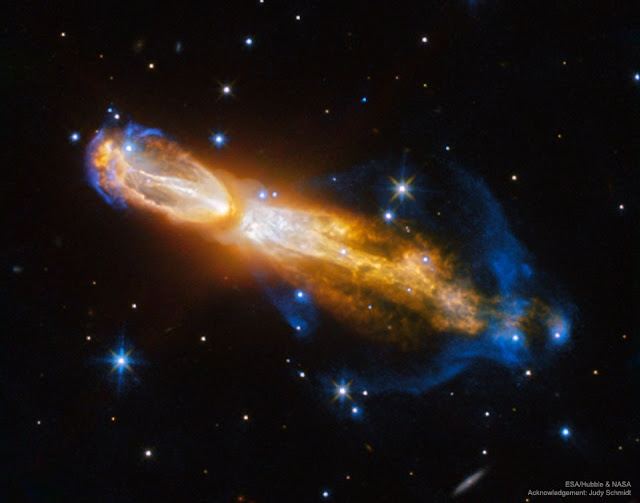Astronomia, astrofísica, astrogeologia, astrobiologia, astrogeografia. O macro Universo em geral, deixando de lado os assuntos mundanos. Um olhar para o sublime Universo que existe além da Terra e transcende nossas brevíssimas vidas. Astronomy astrophysics, astrogeology, astrobiology, astrogeography. The macro Universe in general, putting aside mundane subjects. A look at the sublime Universe that exists beyond Earth and transcends our rather brief life spans.
Pesquisar conteúdo deste blog
quarta-feira, 22 de fevereiro de 2017
The Calabash Nebula from Hubble | A Nebulosa da Cabaça vista pelo Hubble
Nuvens de gás em rápida expansão marcam o fim de uma estrela central na Nebulosa da Cabaça. A outrora estrela normal teve seu combustível nuclear esgotado,levando as regiões centrais a se contraírem em uma anã branca.
Parte da energia liberada causa a expansão do envoltório externo da estrela. Nesse caso, o resultado é uma fotogência nebulosa protoplanetária. Quando o gás movendo-se a um milhão de quilômetros por hora se choca com o gás interestelar circundante, uma frente de choque supersônica se forma, onde o hidrogênio e o nitrogênio ionizados brilham em azul.
Um gás espesso e poeira ocultam a estrela central em colapso. A Nebulosa da Cabaça, também chamada Nebulosa do Ovo Podre OH231.8+4.2, irá, provavelmente, desenvolver-se em uma nebulosa planetária totalmente bipolar nos próximos 1.000 anos. A nebulosa, aqui mostrada, tem cerca de 1,4 ano-luz de extensão, localizada à distância de uns 5.000 anos-luz, na direção da Constelação de Puppis.
Tradução de Luiz Leitão da Cunha
Fast expanding gas clouds mark the end for a central star in the Calabash Nebula. The once-normal star has run out of nuclear fuel, causing the central regions to contract into a white dwarf.
Some of the liberated energy causes the outer envelope of the star to expand. In this case, the result is a photogenic proto-planetary nebula. As the million-kilometer per hour gas rams into the surrounding interstellar gas, a supersonic shock front forms where ionized hydrogen and nitrogen glow blue.
Thick gas and dust hide the dying central star. The Calabash Nebula, also known as the Rotten Egg Nebula and OH231.8+4.2, will likely develop into a full bipolar planetary nebula over the next 1000 years. The nebula, featured here, is about 1.4 light-years in extent and located about 5000 light-years away toward the constellation of Puppis.
Assinar:
Postar comentários (Atom)

Nenhum comentário:
Postar um comentário